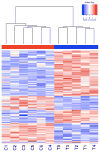Transcriptomic analysis of cell-free fetal RNA suggests a specific molecular phenotype in trisomy 18
- PMID: 21152935
- PMCID: PMC3206603
- DOI: 10.1007/s00439-010-0923-3
Transcriptomic analysis of cell-free fetal RNA suggests a specific molecular phenotype in trisomy 18
Abstract
Trisomy 18 is a common human aneuploidy that is associated with significant perinatal mortality. Unlike the well-characterized "critical region" in trisomy 21 (21q22), there is no corresponding region on chromosome 18 associated with its pathogenesis. The high morbidity and mortality of affected individuals has limited extensive investigations. In order to better understand the molecular mechanisms underlying the congenital anomalies observed in this condition, we investigated the in utero gene expression profile of second trimester fetuses affected with trisomy 18. Total RNA was extracted from cell-free amniotic fluid supernatant from aneuploid fetuses and euploid controls matched for gestational age and hybridized to Affymetrix U133 Plus 2.0 arrays. Individual differentially expressed transcripts were obtained by two-tailed t tests. Over-represented functional pathways among these genes were identified with DAVID and Ingenuity(®) Pathways Analysis. Results show that three hundred and fifty-two probe sets representing 251 annotated genes were statistically significantly differentially expressed between trisomy 18 and controls. Only 7 genes (2.8% of the annotated total) were located on chromosome 18, including ROCK1, an up-regulated gene involved in valvuloseptal and endocardial cushion formation. Pathway analysis indicated disrupted function in ion transport, MHCII/T cell mediated immunity, DNA repair, G-protein mediated signaling, kinases, and glycosylation. Significant down-regulation of genes involved in adrenal development was identified, which may explain both the abnormal maternal serum estriols and the pre and postnatal growth restriction in trisomy 18. Comparison of this gene set to one previously generated for trisomy 21 fetuses revealed only six overlapping differentially regulated genes. This study contributes novel information regarding functional developmental gene expression differences in fetuses with trisomy 18.
© Springer-Verlag 2010
Figures



Similar articles
-
Novel neurodevelopmental information revealed in amniotic fluid supernatant transcripts from fetuses with trisomies 18 and 21.Hum Genet. 2012 Nov;131(11):1751-9. doi: 10.1007/s00439-012-1195-x. Epub 2012 Jul 3. Hum Genet. 2012. PMID: 22752091 Free PMC article.
-
Amniotic fluid RNA gene expression profiling provides insights into the phenotype of Turner syndrome.Hum Genet. 2014 Sep;133(9):1075-82. doi: 10.1007/s00439-014-1448-y. Epub 2014 May 22. Hum Genet. 2014. PMID: 24850140 Free PMC article.
-
Amniotic fluid transcriptomics reflects novel disease mechanisms in fetuses with myelomeningocele.Am J Obstet Gynecol. 2017 Nov;217(5):587.e1-587.e10. doi: 10.1016/j.ajog.2017.07.022. Epub 2017 Jul 20. Am J Obstet Gynecol. 2017. PMID: 28735706 Free PMC article.
-
Obstetrical complications associated with abnormal maternal serum markers analytes.J Obstet Gynaecol Can. 2008 Oct;30(10):918-932. doi: 10.1016/S1701-2163(16)32973-5. J Obstet Gynaecol Can. 2008. PMID: 19038077 Review. English, French.
-
Nuchal translucency and other first-trimester sonographic markers of chromosomal abnormalities.Am J Obstet Gynecol. 2004 Jul;191(1):45-67. doi: 10.1016/j.ajog.2004.03.090. Am J Obstet Gynecol. 2004. PMID: 15295343 Review.
Cited by
-
CSAX: Characterizing Systematic Anomalies in eXpression Data.J Comput Biol. 2015 May;22(5):402-13. doi: 10.1089/cmb.2014.0155. Epub 2015 Feb 4. J Comput Biol. 2015. PMID: 25651392 Free PMC article.
-
Transcriptome Profiling Uncovers Potential Common Mechanisms in Fetal Trisomies 18 and 21.OMICS. 2017 Oct;21(10):565-570. doi: 10.1089/omi.2017.0123. OMICS. 2017. PMID: 29049012 Free PMC article.
-
Pre-pregnancy BMI, gestational weight gain, and telomere length in amniotic fluid: a causal graph analysis.Sci Rep. 2024 Oct 8;14(1):23396. doi: 10.1038/s41598-024-74765-y. Sci Rep. 2024. PMID: 39379607 Free PMC article.
-
The amniotic fluid transcriptome: a source of novel information about human fetal development.Obstet Gynecol. 2012 Jan;119(1):111-8. doi: 10.1097/AOG.0b013e31823d4150. Obstet Gynecol. 2012. PMID: 22183218 Free PMC article.
-
Global gene expression analysis of term amniotic fluid cell-free fetal RNA.Obstet Gynecol. 2013 Jun;121(6):1248-1254. doi: 10.1097/AOG.0b013e318293d70b. Obstet Gynecol. 2013. PMID: 23812459 Free PMC article.
References
-
- Altug-Teber Ö, Walter M, Mau-Holzmann UA, Dufke A, Stappert H, Tekesin I, Heilbronner H, Nieselt K, Riess O. Specific transcriptional changes in human fetuses with autosomal trisomies. Cytogenet Genome Res. 2007;119:171–184. - PubMed
-
- Apweiler R, Attwood TK, Bairoch A, Bateman A, Birney E, Biswas M, Bucher P, Cerutti L, Corpet F, Croning MD, Durbin R, Falquet L, Fleischmann W, Gouzy J, Hermjakob H, Hulo N, Jonassen I, Kahn D, Kanapin A, Karavidopoulou Y, Lopez R, Marx B, Mulder NJ, Oinn TM, Pagni M, Servant F, Sigrist CJ, Zdobnov EM InterPro Consortium. InterPro: an integrated documentation resource for protein families, domains and functional sites. Bioinformatics. 2000;16:1145–1150. - PubMed
-
- Ashburner M, Ball CA, Blake JA, Botstein D, Butler H, Cherry JM, Davis AP, Dolinski K, Dwight SS, Eppig JT, Harris MA, Hill DP, Issel-Tarver L, Kasarskis A, Lewis S, Matese JC, Richardson JE, Ringwald M, Rubin GM, Sherlock G. Gene ontology: tool for the unification of biology. The Gene Ontology Consortium. Nat Genet. 2000;25:25–29. - PMC - PubMed
-
- Baty BJ, Blackburn BL, Carey JC. Natural history of trisomy 18 and trisomy 13: I. Growth, physical assessment, medical histories, survival, and recurrence risk. Am J Med Genet. 1994;49:175–188. - PubMed
Publication types
MeSH terms
Substances
Supplementary concepts
Grants and funding
LinkOut - more resources
Full Text Sources

